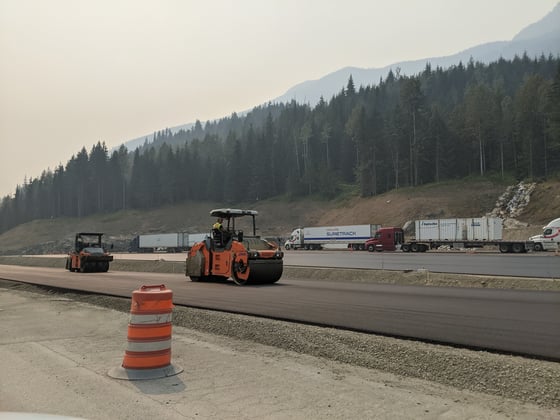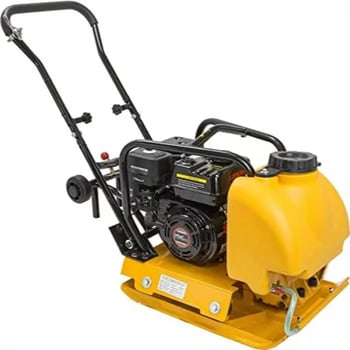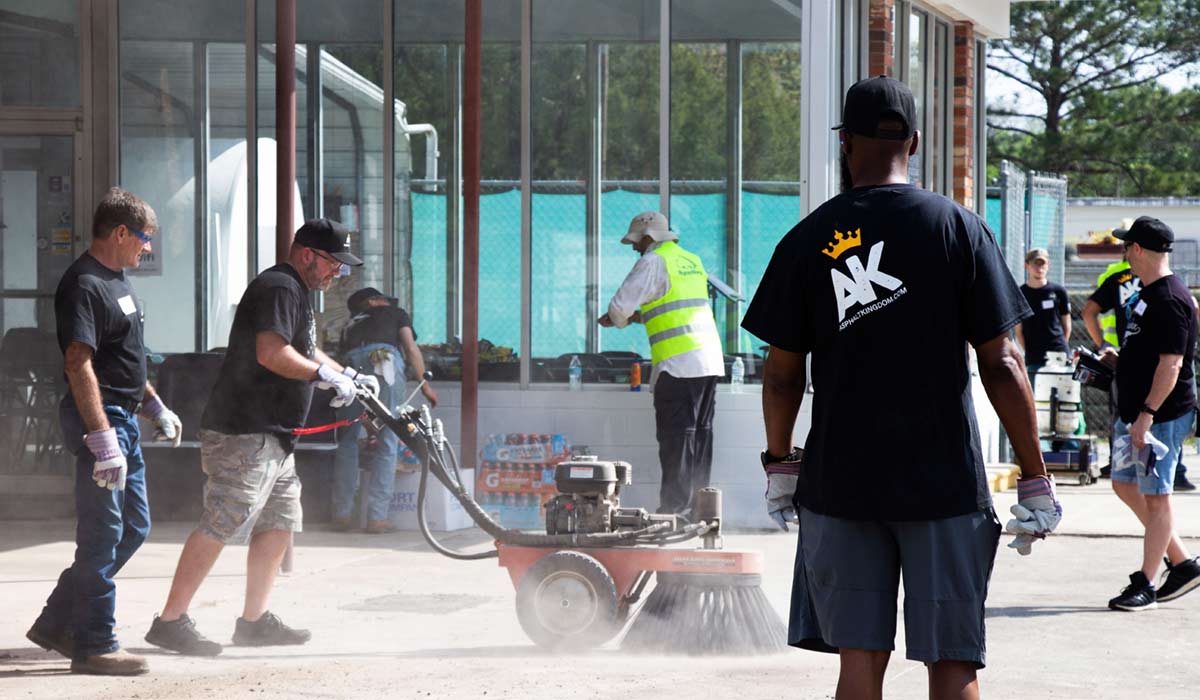- Never underestimate the power of compaction in producing a long-lasting asphalt pavement.
- You can use vibratory rollers or plate compactors to compact patched potholes.
- For road construction or repairing extensive asphalt damage, use a heavy-duty drum roller.
At the heart of the road construction and pothole repair process is the art of compaction – a crucial step that ensures the longevity and durability of our roads. In this article, we delve into the mechanics of compaction, exploring the indispensable tools and techniques that convert loose asphalt into the firm, resilient surfaces beneath our wheels.
Table of Contents
- Compaction Equipment in Asphalt Construction
- Principles of Compaction
- Types of Compaction Equipment
- Compaction Techniques and Best Practices
- Common Challenges and Solutions
- Asphalt Compaction Frequently Asked Questions
- Conclusion
Compaction Equipment in Asphalt Construction
At the heart of every road we drive on, there's a hidden star performer: compaction. It's not just about laying asphalt down; it's how you press and shape it that truly counts. Compaction is the critical final step in asphalt pavement construction, and here's why it’s the linchpin of a road's lifespan.
Think of asphalt compaction like packing a suitcase. You could toss everything in haphazardly, but you'll end up with a mess during your trip.
Proper compaction is akin to carefully folding each item and placing it snugly to optimize space and prevent wrinkles – or in pavement terms, to ensure durability and prevent potholes.
This is where compaction equipment rolls into the picture, quite literally. They eliminate air pockets and densify the asphalt mixture.
The result? A tightly packed surface that can take a beating from traffic and resist the elements. It’s like armor for the road, and the better the compaction, the tougher the armor.
But it’s not just about brute force. Compaction equipment must dance delicately across the asphalt. Too little pressure, and the pavement is a weakling, prone to early failure. Too much, and it's like overworking dough; the asphalt becomes brittle and can crack under the slightest pressure.
This balance is achieved by a range of rollers and compactors – smooth wheeled, pneumatic, and vibratory – all designed to nudge the asphalt into its most durable form.
Principles of Compaction
The fundamental goal of compaction is straightforward: to hike up material density. This process is like packing the ground tighter and tighter, striving for a robust and resilient surface.
It's the equivalent of consolidating a scattered stack of papers into a solid, well-bound book – everything becomes more orderly and far less prone to damage.
When we talk about compaction, we're looking at a very intimate dance between particles and air voids. By pressing the particles closer, we squeeze out those tiny pockets of air. It's a bit like pressing down on a sponge; the less air within, the firmer it becomes.
 Road compaction with a smooth drum roller
Road compaction with a smooth drum roller
In asphalt terms, fewer air voids mean less space for water to infiltrate and fewer chances for freeze-thaw cycles to wreak havoc. This directly translates to a longer-lasting pavement.
As for moisture, think of it as the facilitator of this entire process. Just the right moisture content is crucial – it acts as a lubricant among particles, which helps them slide into a denser configuration under the weight of the compaction equipment.
However, this isn't a more-the-merrier situation. Too much moisture can be just as detrimental as too little. The sweet spot, or optimal moisture content, is when the material is damp enough to be flexible but not so wet that it becomes unstable.
It's a precise balance that, when achieved, ensures maximum compaction efficiency and the best possible foundation for the pavement.
Types of Compaction Equipment
Vibratory Rollers
These rollers are equipped with one or two drums that vibrate, improving the compaction of soil or asphalt by using dynamic force.
Pros
- Excellent for compacting granular soils and hot-mix asphalt.
- Vibrations allow for deeper compaction depths.
- Generally achieves desired density in fewer passes.
Cons
- Not suitable for over-compaction as it can lead to segregation of the asphalt mixture.
- Vibrations may cause disturbance to nearby structures if not properly monitored.
Smooth Drum Rollers
 Smooth drum roller (Photo by Braeson Holland)
Smooth drum roller (Photo by Braeson Holland)
Smooth drum rollers are the traditional choice for compacting fine-grained soils and hot asphalt mixes with their large, smooth steel drums.
Pros
- Provides a smooth finish, ideal for asphalt surfaces.
- Good for flattening and crushing material, ensuring even compaction.
Cons
- Less effective on non-cohesive soils or in areas with large aggregates.
- May require more passes to achieve compaction in certain materials.
Pneumatic Rollers
Characterized by multiple rubber tires, pneumatic rollers provide a kneading action that is excellent for sealing the asphalt surface.
Pros
- Conform to slight variations in the surface, ensuring uniform compaction.
- Adjust tire inflation for varied compaction needs.
- Great for cold laid asphalt mixes and chip seal surfaces.
Cons
- Less effective on very rough surfaces.
- May require additional rolling with a static roller for finishing.
Specialized Compactors
This category includes an array of compactors designed for specific conditions, such as trench rollers, plate compactors, and rammers.
Asphalt Kingdom 6.5 HP Plate Compactor with 5-Gallon Water Tank
Pros
- Capable of accessing tight spaces and difficult-to-reach areas.
- Specific design features tailored to unique compaction needs.
Cons
- Often more expensive due to their specialized nature.
- Limited in their range of application – usually not a one-size-fits-all solution.
Each piece of equipment plays a vital role in the construction and maintenance of durable asphalt surfaces. The selection of the right compactor depends on the job at hand, ensuring that the road or pavement meets all necessary specifications for density and longevity.
Compaction Techniques and Best Practices
Proper roller operation and compaction patterns are not just part of the job; they're the art form that ensures a pavement's long-term performance.
It's like the difference between a haphazard brush stroke and a master painter's technique—both might use the same paint, but the outcome is worlds apart.
When you're orchestrating the movement of rollers, it’s all about rhythm and coverage. Overlap each pass with precision and maintain a consistent speed to avoid creating ripples or inconsistencies. It's similar to mowing a lawn in neat, overlapping rows to ensure every blade of grass is cut just right.
Now, let's consider the factors that can make or break your masterpiece.
Lift Thickness. This is the layer's depth you're compacting. Too thick, and the roller won't be able to cozy up those particles at the bottom; too thin, and you might overwork the material.
Each layer must be just right to ensure the roller can effectively transmit its energy into the mix.
Material Type. Like choosing the right type of clay for pottery, selecting the right asphalt mix for the job at hand is crucial. Dense-graded mixes might require different compaction techniques compared to open-graded or stone-matrix asphalts.
Achieving uniform compaction is like ensuring the heat is evenly distributed when you're cooking a gourmet meal. You don't want one side to be perfect while the other's underdone.
It requires consistent monitoring, adjusting the number of passes, and ensuring the roller doesn't deviate from its course.
The use of GPS and machine guidance technologies is becoming a game-changer, helping operators maintain even compaction across the whole surface.
Common Challenges and Solutions

When dealing with variations in asphalt mix properties, it's like being a chef faced with ingredients that aren't quite what the recipe called for. You've got to adjust your technique. If the mix is too stiff, you might need to increase the temperature or switch to a roller that can apply more force.
When it's too tender, on the other hand, you'd look at reducing the temperature or using equipment that's a bit gentler, to avoid pushing the aggregate into the binder.
Achieving specified compaction densities is akin to hitting the bullseye in archery; it takes skill and practice. If you're falling short, first look at your roller patterns.
Are you overlapping correctly? Is the speed consistent? Sometimes, it's a matter of calibrating your equipment – ensuring vibratory rollers are set to the right amplitude and frequency to compact the mix thoroughly without over-compaction.
Then there's the ever-changing canvas of environmental factors. Temperature fluctuations can make or break your compaction efforts. Too cold, and the asphalt won't be workable; too hot, and it can deform under the roller.
It's a balancing act – monitoring the weather and adjusting your compaction windows accordingly. And it's not just about the air temperature; the base temperature is just as crucial.
Moisture is another slippery character in this story. A little moisture can be beneficial, but too much and you might as well be trying to compact a sponge. It's essential to ensure your base is dry and your working environment is free from unexpected rain showers.
In dealing with these challenges, remember that flexibility and adaptability are your best allies. By understanding the materials you're working with and respecting the environmental context, you can adjust your compaction strategies to turn potential obstacles into mere bumps in the road—bumps that you'll deftly smooth over with expertise and finesse.
Asphalt Compaction Frequently Asked Questions
1. What is the primary purpose of compaction equipment in asphalt construction?
The primary purpose of compaction equipment in asphalt construction is to densely pack the asphalt material, reducing air voids to create a smooth, stable surface that can withstand traffic and the elements.
2. How does compaction contribute to the durability of asphalt surfaces?
Compaction increases the asphalt's density, making it more resistant to water penetration, weathering, and traffic stress. This leads to a longer lifespan and less need for frequent repairs.
3. What are the key principles governing the compaction process?
The key principles include achieving sufficient material density, reducing air voids to an optimal level, and maintaining appropriate moisture content to allow particles to move into a tighter configuration.
4. What are the different types of compaction equipment commonly used in asphalt construction?
Common types include vibratory rollers, smooth drum rollers, pneumatic rollers, and specialized compactors like plate compactors and rammers.
5. How do vibratory rollers differ from smooth drum rollers in asphalt compaction?
Vibratory rollers use vibrations to enhance compaction depth and efficiency, particularly in granular materials. Smooth drum rollers rely on static weight and are better suited for finishing surfaces and compacting fine-grained soils.
6. What are the main challenges faced when achieving proper compaction in asphalt construction?
Challenges include managing variations in asphalt mix properties, achieving the specified density, addressing temperature impacts during compaction, and controlling moisture levels both in the working environment and in the asphalt mix itself.
Conclusion
Ready to ensure your customer's asphalt lasts for many years? Order your asphalt roller, plate compactor, or even a simple tamper tool from Asphalt Kingdom today! Get in touch with us at 866-399-5562 or send a message to sales@asphaltkingdom.com to learn more about these machines or to order.








